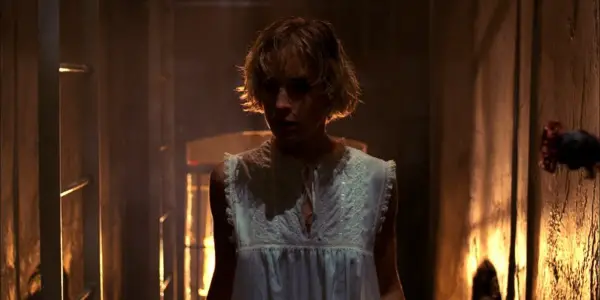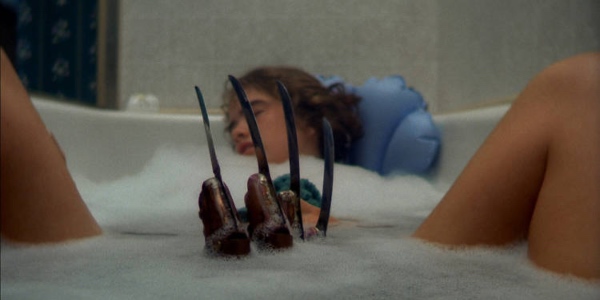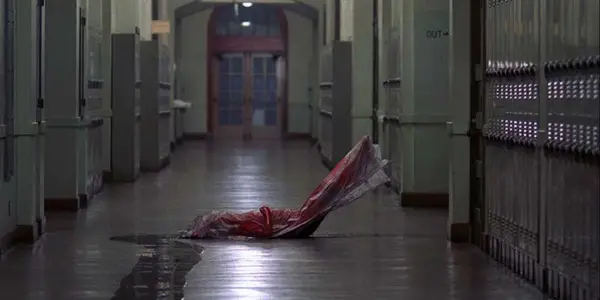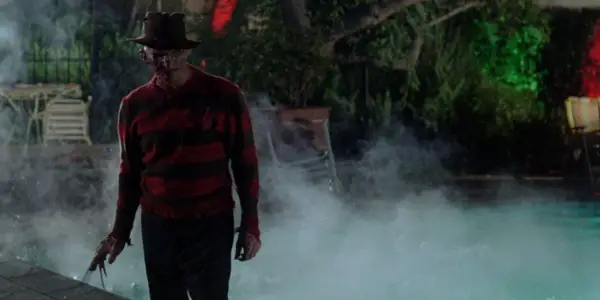Horrific Inquiry: A NIGHTMARE ON ELM STREET (1984)

Stephanie Archer is 39 year old film fanatic living in…
Welcome back to the scariest, and at times goriest, column here at Film Inquiry: Horrific Inquiry. Twice a month, I will be tackling all things horror, bringing two films back into the spotlight to terrify and frighten once more. And occasionally looking at those that could have pushed the envelope further. Join us as we dive deep into the heart of horror, but warning, there will be spoilers.
“Whatever you do, don’t fall asleep” – A Nightmare on Elm Street (1984)
From music to cinematography, script to screen, Wes Craven‘s A Nightmare On Elm Street is an everlasting dream terror. A horrific blood bath of film, A Nightmare on Elm Street elevates itself beyond the traditional slasher film, reaching into the subconscious and looking back at its audience. Though it never forgets its roots, delivering high intensity kills, an unforgettable legendary performance by Robert Englund and a finale that leaves room for interpretation.
Razor Execution
A Nightmare on Elm Street has little buildup, immediately introducing its central killer. While we never actually fully see him in the film’s opening moments, we watch as he fashions his iconic slicing knives through close-ups, the music cutting through you with a deep sense of horror. An edge of your seat razor composition, composer Charles Bernstein crafts an eerie leitmotif that would become synonymous with Freddie Krueger (Robert Englund) and the film as a whole. As the small aspect ratio opens up to full screen, we are no longer watching snapshot videos of a killer coming to life through a craftsmanship of weaponry, but rather through a means of destruction.

The terror on Tina’s (Amanda Wyss) face, as she runs down the darkened alley, speaks to an unseen horror, one we have only been given small bits of thus far. As she makes her way into the boiler room, A Nightmare on Elm Street continues to be coy with its audience. It continues to only give little bits of its killer, heightening the fear of what is stalking Tina and lurking in the shadows. There is never enough to craft a complete picture, a close up of Freddie’s burned eyes, the back of his hat and his devilish laughter terrifyingly filling the senses. And while he may finally jump out to ensnare Tina, it is still not the whole picture, his hat keeping his full face fully obscured.
As Tina wakes up, her screams harmonizing with the screeching sound of Freddie’s knives, we come to understand it was “just a dream”, castles and mist replaced with hard steal and the steam of the boilers. And even though the dream has ended, audiences will find they can still hear the scratching of metal on metal, our senses heightened as we begin to question realty and fiction, Tina showing her audience the cuts in her pajamas.
Craven is a master of suspense and horror, skilled at executing an effective beginning that goes beyond just a basic introduction. Dedicated to committing to the terror from the moment the film begins, Craven‘s script and filming waste no time locking its audience in.
A Blood Bath
Following the film’s opening sequence, audiences are introduced to Nancy (Heather Langenkamp), Glen (Johnny Depp) and Rod (Jsu Garcia) as they make their way to school with Tina. While still shaken, Tina finds reassurance in the fact that the others have had nightmares as well. Though as a savvy horror audience, there is an ominous foreboding in the subtle and mundane conversations between them. As the film transitions to Tina’s house that night, the conversation of nightmares grows, Nancy and Tina discovering they may be dreaming of the same burned man. Yet, where the dream conversations continue, so too does the film’s foreshadowing. As Tina and Rod drift off to sleep, Rod pulls a red and green stripped blanket over himself, the camera outside the house capturing the silhouettes of tree branches, their tips resembling razors as they reach for the window.

The small details are a quiet and quick passing as Tina’s dreams start once again. It is here that A Nightmare on Elm Street presents its first kill – and what a bloody and brutal one it is. Though this is not without a game of cat and mouse first. Krueger is not satisfied with just murdering the children. He needs them to be terrified. He needs their terror to fuel the others. He feeds off their fear, growing stronger with each dream. He accelerates this fear and terror in his victims until he is strong enough to take their life. Cutting his fingers with his razors, blood spurting out, and slicing his chest to reveal green puss and maggots are some of the visual forms of terror he utilizes to fan the fear and feast off its flames.
As we watch Tina’s futile attempt to fend off Freddie Krueger, he slices her stomach. And as Rod watches her attacked by an unseen assailant, Craven pushes the limits of gore, dragging her blood soaked body up the wall of the bedroom, pinning it to the ceiling above. As Tina and Rod scream, it is too late, Tina’s limp and bloody body falling back down to the bed, blood splattering on Rod – effectively marking him as Freddie’s next target. This murder is not only a horrific one, but sets the expectation for the remainder of the film. This blood bath continues later on as Glen succumbs to exhaustion, falling asleep. His murder is one of cinematic greatness, especially within the horror genre.
Filmed in a room staged upside down, an on screen a geyser of blood shoots from the bed he was pulled into. As the blood hits the ceiling, there is a continuity with Tina’s murder, the blood rippling out across the ceiling, almost pinned in place. Yet, the graphic nature of the scene becomes a representation of Krueger’s growing power, his affect outside of the dream world becoming more intense and horrifying.
Reflection of the Subconscious
But it is not just the blood bath that makes A Nightmare on Elm Street effective, but its restraint from the bloody gore throughout the film. Craven is not satisfied with just epically crafted blood baths, playing with his audience as much as he does Nancy. This imagery, like its crafted effects, also continues to hold up almost 40 years after the film’s release. There is a meticulous and intentional inclusion in much of these visuals. And while the bugs coming out of Tina’s mouth and slithering creatures leave behind the blood, there is one scene in particular that truly elevates.

Following Tina’s death, Nancy decides to head to school. While her teacher, played by Lin Shaye, enlists a fellow student to read aloud, Nancy doses off. Though we don’t actually see her go to sleep, we know that she is dreaming, the sound of the student’s monotone voice encompassing hints of Krueger’s. Then, there is also the visually terrifying Tina in a body bag calling to Nancy that confirms any remaining suspicions. As Krueger begins to enact his game of cat and mouse with Nancy, there is an awareness that he needs to go further. That Nancy is harder to truly scare than the others.
As Nancy follows the sounds of Tina calling to her and the trail of blood outside the classroom door, we see Tina laying on the ground in the body bag. As her legs elevate and she is dragged away by an unseen force, what we do notice is her dead limp arm falling out and hitting the floor. It is here A Nightmare On Elm Street elevates beyond a traditional slasher. Before leaving for school, Nancy’s mother raced to turn off the TV with horrific coverage of Tina’s murder. Before turning the TV off, Tina’s body is shown in a body bag being taken away, her dead limp arm falling to the side. In this moment, Craven quietly takes on the psychology of fear and the subconscious. In this moment, even when we know that Krueger is real and killing teenagers, we are left to question if the movie itself itself is a reflection of the subconscious. And while this many seem a small moment, the film’s ambiguous ending seems to further heighten the possibility.
Building A Mystery
There is a subtly in A Nightmare on Elm Street‘s underlying mystery – why is Krueger doing this? Each slasher killer has an underlying reason for their horrific murders. For Krueger, it is the time old tale of revenge – trespassing in the dream world to kill the children of the parents who killed him. A Nightmare on Elm Street leans into this, giving small pieces of this mystery before tying them all together. We are shown Nancy’s mother’s (Ronee Blakley) alcoholism, one that just seems a random detail at first. Then exchanges between mother and father (John Saxon) as Nancy begins to recall who she saw in her dream.

Halfway through the film following Rod’s death, A Nightmare on Elm Street begins to put the pieces together, making a deeper connection more apparent. As the priest at Rod’s funeral states “those who fight by the sword die by the sword”, viewers will notice a brief exchange between the parents. As Nancy pushes her mother about the hat she pulled out of her dream at the sleep clinic, it all begins to fall into place. She reveals to Nancy that Freddie Krueger can’t hurt her because mommy killed him. As the words and explanation of what she, and other parents, did to prevent Krueger from hurting children, it all comes into focus.
We understand the divorce between Nancy’s parents, the guilt ridden alcoholism, the exchanged glances and most importantly, the motive. This is no longer just another slasher set out to create a high body count and horrifically graphic blood baths. This is a horror that dives into the wells of psychology. As A Nightmare on Elm Street approaches its ambiguous conclusion, each of these elements comes into pay to understand what might be the truth within the fiction. And as Nancy’s mom falls victim to to Krueger in both dream and reality, you further understand that she may not have been the participant but rather the conspirator.
Conclusion
Where Michael Myers was the boogie man of the late 1970s, Freddie Krueger was for the 80s. And while the sequels, and subsequent remake, would never live up to the magic of the original, A Nightmare on Elm Street launched a franchise that would inspire and retain relevance.
Have you seen A Nightmare on Elm Street? What did you think? Let us know in the comments below!
Watch A Nightmare on Elm Street
Does content like this matter to you?
Become a Member and support film journalism. Unlock access to all of Film Inquiry`s great articles. Join a community of like-minded readers who are passionate about cinema - get access to our private members Network, give back to independent filmmakers, and more.












